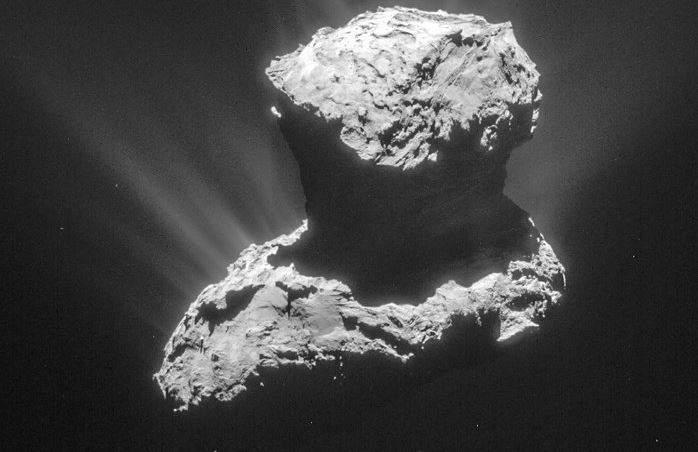Life's building blocks discovered on comet by ESA's Rosetta probe
The building blocks of life have been discovered in a cloud of gas and dust surrounding a comet, bolstering the notion that these celestial objects delivered them years ago to earth and throughout the solar system. Scientists involved in the Rosetta probe mission made the find around the icy body known as Comet 67P/Churyumov-Gerasimenko.
The European spacecraft found clear evidence of glycine – an amino acid used by living organisms to make proteins – and phosphorus, which helps build DNA. Scientists reported the find in research published in the peer-reviewed journal, Science Advances.
"It shows that even the very primitive bodies like comets contain a complex chemical soup, independent of [the] sun and Earth," said Kathrin Altwegg, lead author of the research from the University of Bern. "They contain everything needed for life – except energy."
She added: "This is the first unambiguous detection of glycine in the thin atmosphere of a comet."
Glycine is the smallest of the 20 amino acids that form the protein "alphabet" which link together in chains to create proteins – the large molecules that are fundamental to the structure and function of living cells.
The findings appear to bolster the idea that "dirty snowballs" could have played a role in starting life on Earth. It suggests that extra-terrestrial objects crashing into our planet could have could have brought chemicals crucial to the emergence of life.
#67P contains ingredients for #life! Supports idea comets delivered key chemistry to #Earth https://t.co/ytPepvtqlp pic.twitter.com/iqTyYXlbKS
— ESA Rosetta Mission (@ESA_Rosetta) May 27, 2016
Amino acids – the building blocks of proteins – have already been discovered on meteorites but this new research adds weight to the notion that comets could also have played a role.
"The multitude of organic molecules already identified by Rosina, now joined by the exciting confirmation of fundamental ingredients like glycine and phosphorous, confirms our idea that comets have the potential to deliver key molecules for prebiotic chemistry," Rosetta's UK project scientist Dr Matt Taylor told Sky News.

"Demonstrating that comets are reservoirs of primitive material in the solar system, and vessels that could have transported these vital ingredients to Earth, is one of the key goals of the Rosetta mission, and we are delighted with this result."
Rosetta reached Comet 67P/Churyumov-Gerasimenko in August 2014 after a four billion mile (4.03AU) journey that took 10 years.
While the data gathered by its many instruments will keep scientists busy for years to come, the mission is currently expected to end in September when the craft will be directed into a slow collision course with the surface of Comet 67P.
© Copyright IBTimes 2025. All rights reserved.





















